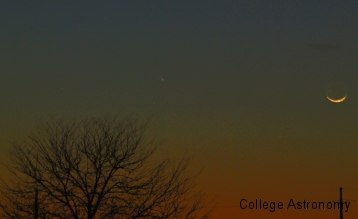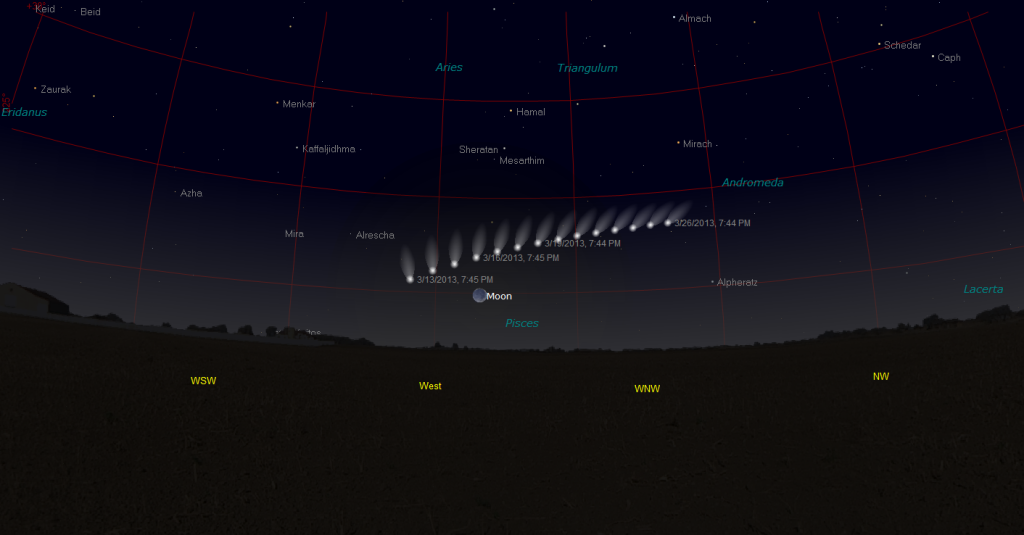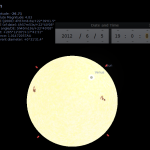We've had a few comets come through here and there over the past few years without much hype. While this will not be as spectacular as Hale-Bopp or Hyakutake back in the late 90's, this month's comet PanStarrs (Designation C/2011 L4 PANSTARRS) will still provide a spectacle in the evening skies (weather and view permitting). The comet visits the Northern Hemisphere and be visible to the West in the evening skies starting this week.
You'll need good viewing conditions to the West and an unobstructed view, I would suggest a high point looking west as your best chance sine this comet will be fairly close to the horizon.
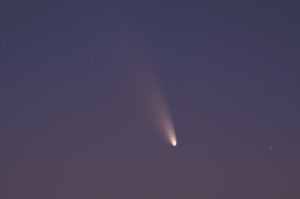
Close-up of comet C/2011 L4 PANSTARRS as seen from Mount Dale, Western Australia. Image credit: Astronomy Education Services/Gingin Observatory
The most important aspect of this comet for the average person is that this comet will be visible to the naked eye which means you won't need to have binocolars or a telescope to view it. However, for best viewing observing equipment such as a telescope or binoculars are certainly encouraged. You might check your local astronomy organizations for possible viewing opportunities and star parties related to the comet.
In the Eastern Kansas area you can find information at the following sites:
Northeast Kansas Amateur Astronomers' League
Astronomy Associates of Lawrence
Astronomical Society of Kansas City
If you're unsure of organizations around you, an excellent resource for this is the Astronomical League as they keep track of most (but not all, so try Google if you don't find one) amatuer astronomy organizations and can provide links to their sites.
Now, back to the comet. Based on it's name we can see that it was discovered in 2011 by the Panoramic Survey Telescope and Rapid Response System which sits near the top of the Haleakala volcano in Hawaii. Until recently, the comet has been visible primarily in the Souther Hemisphere but as it rounds the Sun, that will change, giving way to our viewing pleasure in the Northern Hemisphere.
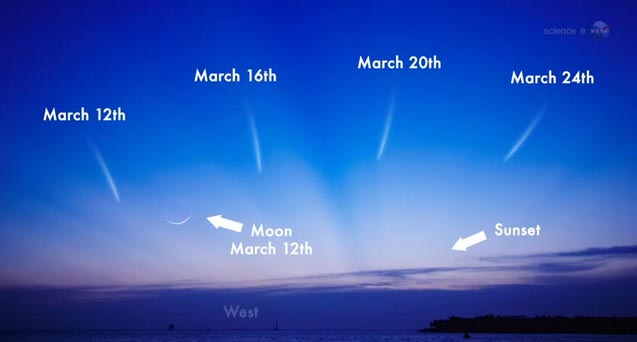 The chart here shows you rough positioning of the comet as it makes it's way through the sky. This image is courtesy of NASA.
The chart here shows you rough positioning of the comet as it makes it's way through the sky. This image is courtesy of NASA.
Viewing Points
The comet reaches it's closest approah to the Sun on March 10th and the expected return to visibility is March 12th. However, with luck and assistance you may be able to pick it up on March 11th.
One important viewing tid bit for this comet is that you do need to pay close attention to your viewing time. Because this comet is low in the Western sky it presents a time problem, too early and the sun will still be up and if you try later it will be either obstructed by trees, hills, atospheric distortion or the lot of it. Assuming you have low pollution and reasonably good weather, you can probably start looking at about 15 minutes past sunset. For Lawrence, KS on March 11th this would be roughly at 7:40 PM local time. To spot it you'll want to look around 8 degrees South of West and around 10 degrees above the horizon. The easy way to do this is to remember that outstreched your fist is roughly 10 degrees plam horizontal and 5 degrees palm verticle. So this would mean, it would be a little more than 1 fist width verticle to the left of where the Sun set and around 1 fist with horizontal above the 0 point of the horizon.
Over the course of the next several weeks the comet will be travelling from South to North along the Western horizon and getting further away from the Sun so the observing times will increase. However, this is a tradeoff since the further away from the Sun the comet gets the less of a tail it will exhibit and the dimmer it will get. That's part of the reason why this upcoming week beginning March 11th will present the best time to view.
Comet visibility will be best this week and will taper off through the end of the month of March when it will once again become difficult to detect even with optical aides like binoculars or telescopes. Don't wait to see it!
There are a few points of interest over the next week for those viewing the comet. I'm going to detail them out and provide pictures below. All pictures made with Stellarium.
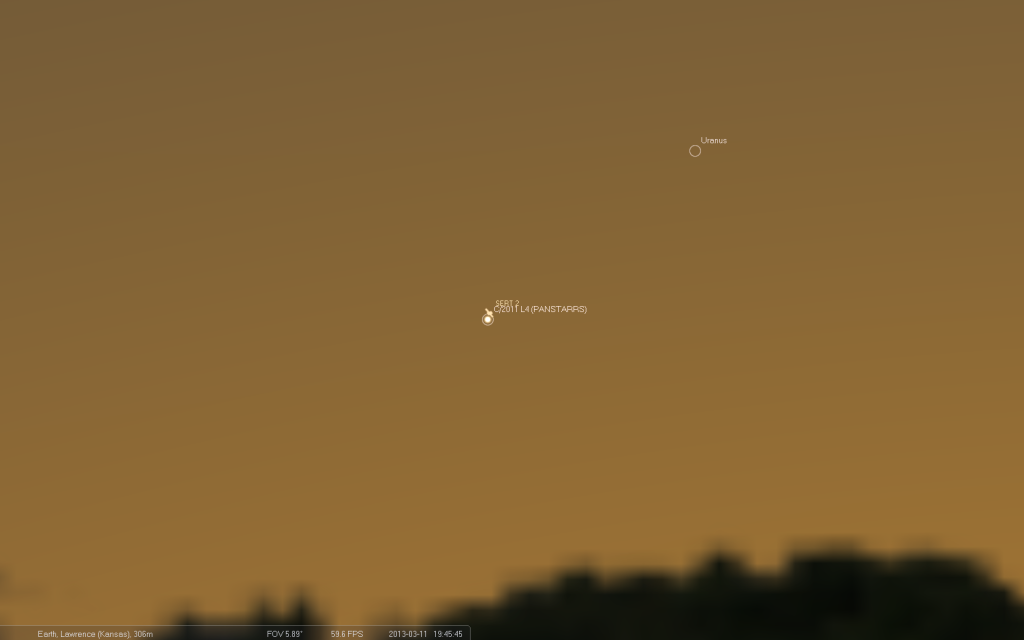 March 11th 2013 19:45:45 – Lawrence, KS – Comet C/2011 L4 PANSTARRS and satellite SERT 2 pass within 3 angular minutes of one another. This event will happen very fast and may not be visible due to sunlight, the comet was closest to the Sun just one day ago. If you are seconds early or late you will not see this as the SERT 2 satellite crosses the entire sky in only seconds. This will happen again over the course of the next several weeks as well as with a few other satellites (all from Lawrence), METEOR-PRIRODA, NOAA 15, SL-6 R/B(2), COSMOS 1500, COSMOS 2242, AJISAI (EGS) to cite a few. Additionally, it should be noted that most of these kinds of sightings will be very subjective to your geographical location and may not be visible from where you're at. You might have better visibility for other satellites posing for photo ops with the comet because of that. Since these sightings will be brief and require precision, I suggest that you either download Stellarium or find other resources to help you plan your observation.
March 11th 2013 19:45:45 – Lawrence, KS – Comet C/2011 L4 PANSTARRS and satellite SERT 2 pass within 3 angular minutes of one another. This event will happen very fast and may not be visible due to sunlight, the comet was closest to the Sun just one day ago. If you are seconds early or late you will not see this as the SERT 2 satellite crosses the entire sky in only seconds. This will happen again over the course of the next several weeks as well as with a few other satellites (all from Lawrence), METEOR-PRIRODA, NOAA 15, SL-6 R/B(2), COSMOS 1500, COSMOS 2242, AJISAI (EGS) to cite a few. Additionally, it should be noted that most of these kinds of sightings will be very subjective to your geographical location and may not be visible from where you're at. You might have better visibility for other satellites posing for photo ops with the comet because of that. Since these sightings will be brief and require precision, I suggest that you either download Stellarium or find other resources to help you plan your observation.
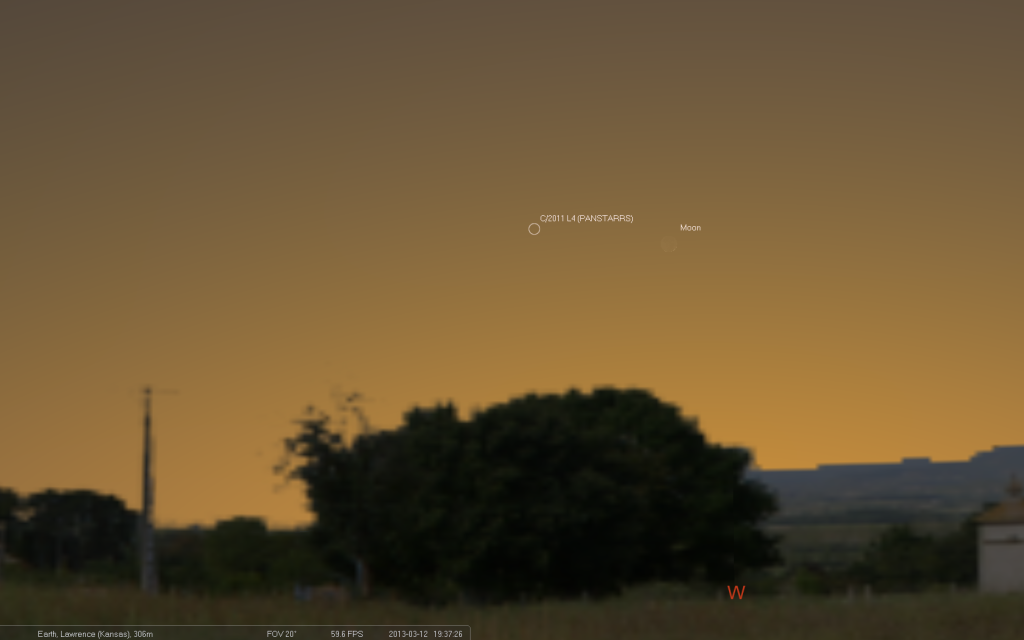 March 12th 2013 All Visible Time – Everywhere – Comet C/2011 L4 PANSTARRS and the New Moon will be close enough to make for some interesting photo ops as they will be less than 5 degrees apart.
March 12th 2013 All Visible Time – Everywhere – Comet C/2011 L4 PANSTARRS and the New Moon will be close enough to make for some interesting photo ops as they will be less than 5 degrees apart.
Depending on how things play out, you may also find some good shots with Mars on the lower horizon as well since it is on it's move into the evening sky as well but with the comet moving away from it, these chances are subjective at best.
In any case, this event should prove to be a great opportunity to strech your legs, get some fresh evening air and see a great astronomy event. I'm including some (hopefully) helpful technical and less technical links below:
Oribtal details can be found at the JPL site: http://ssd.jpl.nasa.gov/sbdb.cgi?sstr=C/2011+L4
This site will provide you a general idea of where the comet is with respect to other astronomical objects: http://www.heavens-above.com/comets.aspx?lat=0&lng=0&loc=Unspecified&alt=0&tz=UCT
Several good images and some additional information can be found here: http://earthsky.org/space/comet-panstarrs-possibly-visible-to-eye-in-march-2013

